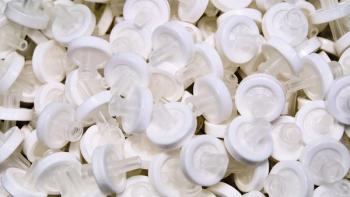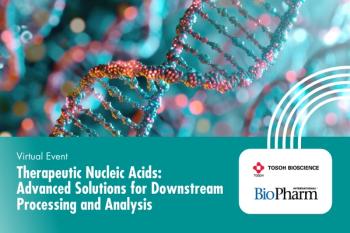
- BioPharm International-09-01-2011
- Volume 24
- Issue 9
Technologies for Downstream Processing
The author describes recent developments to help overcome the downstream-processing bottleneck.
Biologics comprise a huge variety of different molecules, activities, and applications and mostly try to mimic functions of natural molecules. Generally, they are of a rather complex nature and often consist of different functions on the same molecule (e.g., Fc receptor and antigen-recognition site of an antibody). Typically, proteins can present different possible modifications, such as glycosylation, disulfide bridges, specific carbon and nitrogen terminal groups, or they have been chemically modified, such as pegylated or conjugated proteins. Biologics may be based on carbohydrates (e.g., the meningitis vaccine), peptides (e.g., insulin), lipid structures, parts of microorganism cell walls, complete cells (e.g., stem-cell treatments, or Bacillus Calmette-Guérin (tuberculosis vaccines), or nucleic acids (e.g., plasmids and genome DNA for gene therapy). Furthermore, the active substance or complex does not consist of one molecule, but a mixture of different ones, such as congeners and isoforms. The ratio of each molecule within the mixture of the family can be crucial for activity. The importance of this ratio becomes more and more visible as analytical methods advance.
ADVANCES IN UPSTREAM PROCESSING
This extremely large variety of molecules necessitates a broad range of production systems, and analytical characterization and quantification methods. Most first-generation biological products were extracted from natural sources, such as animal tissue, human plasma, and wild stem microorganisms, and further separated with basic techniques (e.g., precipitation, centrifugation, and filtration). However, because of the risk of contamination and incompatibility, these traditional techniques have been replaced by more advanced biotechnologies, such as recombinant techniques or methods that can significantly reduce the potential level of contaminants. These methods include solvent, heat, gamma irradiation and microwave treatments, nanofiltration, and anion exchange chromatography. Initial hybridoma monoclonal antibodies or fusion proteins have also been replaced by humanized ones, and the third generation of biologics now focuses on further defined structures with less microheterogeneities and fewer aggregates to avoid adverse immune reactions. Another focus of new technologies is the expression of antibodies or antibody fragments that provide certain functions by, for example, being linked to cell-killing antibody drug conjugates.
In the 1990s and the early 2000s, much progress was made in biological upstream processing with productive high-expression systems, effective clone selection, defined culture media, process intensification and single-use components. Progress also was made with regard to improvements in analytical methods, which were developed to further characterize and quantify molecules in terms of structure, identity, activity, purity, microheterogeneity, quantification, and safety. These advances were crucial for downstream development because they helped to further characterize starting materials, thereby providing more insight into quality and mass balance during processing. As such, target specifications are now stricter and more demanding compared with early biologics.
OVERCOMING DOWNSTREAM CHALLENGES
These upstream developments create challenges in downstream processing to ensure that the biologics achieve the new quality and safety specifications. Other challenges for downstream processing include treating high upstream quantities in time, integrating new chemistries, purifying molecules in a contained system that enables the handling of antibody drug conjugates, and, of course, ensuring that processes are cost effective. Recent developments in the downstream area, however, are helping to overcome these challenges.
Process analytical technologies (PAT)
The development of more effective analytical methods has enabled better control over critical quality and quantity attributes online and atline during downstream processing. FDA encourages the use of these technologies and defines them as "a system for designing, analyzing, and controlling manufacturing through timely measurements (i.e. during processing) of critical quality and performances attributes of raw and in-process materials and processes with the goal of ensuring final product quality" (1).
Cycle time, sample preparation, and the nature of the analytical method are key to determining whether on-line or at-line measurement can be developed. Several other factors also need to be considered when implementing a PAT solution. These factors include the following: the design of the fluid pathway; communication between the measuring software and process software; knowledge about the analytical methods' stability, reproducibility, repeatability and precision; linearity; and limits of quantification combined with processcontrol needs. It also is important to determine whether the techniques should be applied only in process development or in the production of commercial material as well. Systems for in-line dilution (ILD) of buffers or clean-in-place (CIP) solutions are examples that have been installed at the industrial scale. The principle of an ILD system is the preparation of buffers and cleaning solutions by using concentrated stock solutions that are diluted with water to the desired final concentration. These systems must be robust to compensate for the pressure changes of the water preparation loops, backpressure from process units (e.g., tangential flow filtration (TFF) or chromatography), and changes in buffer composition and dilution rates. The principle of ILD is shown in Figure 1.
Figure 1: Principle of in-line dulition. TFF is tangential flow filtration. (ALL FIGURES COURTESY OF THE AUTHOR)
Depending on user requirements, different technical solutions can be used for the dilution itself (e.g., pumps coupled with mass flow meters, analogue or proportioning valves) to ensure that the inlet pressure is adequately controlled, and the control of the composition after the dilution (e.g., conductivity feedback control on the pumps or valves). Cost analysis has shown that these rather simple solutions can save up to 20% in capital expenditure for new downstream plants (2).
Another example of PAT application concerns atline monitoring and product quality control during the chromatographic elution of a mixture of lipidic compounds, which ensures that the correct chromatographic fractions are selected. In one particular case, because the compounds are not ultraviolet active, a light-scattering method was developed to follow the elution profile. In a second step, an analytical method based on mass spectrometry was implemented to control the composition of the different lipids. The work commenced with off-line analyses at bench scale and continued with experimental at-line analyses, including split streams. After the initial laboratory-scale phase, the process and analytical tools were scaled up to find the optimal technical solution for implementation in an industrial cGMP environment. Figure 2 presents the evaporating lightscattering detection (ELSD) at-line measurement, coupled with a preparative high-performance chromatography (HPLC) system, which was used in the study. A very small part of the elution stream that comes from the HPLC is directed to a splitter and transferred to the light-scattering detector. Because organic solvents are used, a nitrogen purge box is necessary. Using this solution, the time for in-process sample analysis was reduced to one day, compared with approximately two weeks with initial analytical methods. The investment and the time of implementation and validatioin need to be balanced with the gain of operational time.
Figure 2: Principle of at-line measurement using evaporating light-scattering detection (ELSD). HPLC is high-performance liquid chromatography. (ALL FIGURES COURTESY OF THE AUTHOR)
Single-use systems
The introduction of single-use components into biological production processes started in the early 1970s with liquid filters and tubings, but by the end of the 1980s, bags also became available for storing small volumes. The beginning of the 2000s saw the development of fully-disposable upstream harvest lines and further development of bufferpreparation systems. Today, single-use cell culture reactors up to 2000 L and bioreactors up to 500 L are available on the market. Research also is ongoing to find high-quality, economical solutions for TFF and chromatography single-use systems.
There are many advantages associated with single-use systems, including reduced changeover times (i.e., cleaning, setup, and storage), reduced cross-contamination risks, availability of fully contained systems, reduction of initial capital expenditure (in most instances), reduced set-up time, and reduced cleaning validation. These benefits, however, also must be balanced with other factors, including risk of leachables, compatibility problems, integrity failures, supply-chain interruptions, scalability limitations, waste management, and operational cost evaluations. A detailed case-by-case evaluation should always be conducted, particularly for routine production. Figure 3 shows an image of single-use TFF cassettes used for concentration, diafiltration, and the formulation of biologics.
Figure 3: Tangential flow filltration cassettes. (ALL FIGURES COURTESY OF THE AUTHOR)
Specific ligands and chromatographic media
Being able to obtain a high-quality product after only two or three purification steps is a real achievement in the process development of biologics. However, the process also needs to be scaleable with high productivity. Specific ligands coupled to rigid chromatographic media for the targeted product can be beneficial in this process. One prominent example is a typical antibody capture step with Protein A ligands, which can reach up to 90% purity. Ligands can also be developed to polish impurities, such as residual host cell proteins and transmissible spongiform encephalopathies particles. In the case of polishing, the capacity is less important, so ligands could be coupled onto membranes to create membrane adsorbers.
With regard to the specificity and stability of the ligand, the structure (i.e., particle size, size distribution, pore size, pore distribution, mechanical and chemical stability) of the chromatographic beads and the coupling chemistry are also important. Optimized chromatographic media can increase process performance. In terms of mechanical and chemical stability, pore size, pore size homogeneity and the coupling chemistry are important for membrane adsorber development.
Productive process dimensioning
Traditional production processes for biologics are batch based, which means that almost every process flow is collected after each step in one or several tanks, and often checked for product quality before processing in the next step. Based on development data, processes could often be more intensive.
In addition to the biopharmaceutical industry, the process intensification phase is mandatory for other industrial biotechnology sectors such as the processing of antibiotics, amino acids, organic acids and food ingredients. One recent example where a process migrated from an industrial biotechnology platform to biopharmaceutical production is sequential multicolumn chromatography (SMCC). This process allows the use of processing time as another dimension; therefore, velocity, resin volume, and the number of columns can be calculated to fit in a predefined processing time. A significant increase in productivity can be reached (Examples on Protein A antibody capture showed up to a threefold increase). Buffer and stationary phase consumption was also cut by at least half (3). This process also can enable continuous downstream processing, where the process steps are connected to each other to obtain a continuous process flow up to the bulk stage.
Figure 4: Principles of a sequential multicolumn chromatographic (SMCC) process and comparison with a batch one. (ALL FIGURES COURTESY OF THE AUTHOR)
Cost studies on monoclonal antibody downstream processing performed by BioPharm Services showed up to a 79% reduction in operational cost when processes were transformed from batch to continuous ones (4). Additionally, process simulation tools are important to optimize process dimensioning, production and investment costs, which also can be a support for process characterization and validation. Figure 4 shows the principles of the SMCC process and compares it with a batch one. Figure 5 shows an industrial system that enables the operation of SMCC processes.
Figure 5: Example of an industrial system that allows sequential multicolumn chromatography. (ALL FIGURES COURTESY OF THE AUTHOR)
CONCLUSION
In light of the numerous challenges in biologics processing, such as the wide variety of molecules and applications, increased quality and regulatory requirements, and cost pressure on drug financing, the development of new downstream processing technologies is essential.
Applying PAT systems, such as ILD systems and at line monitoring, can significantly increase process control and aid cost reduction. Further development of chromatographic media or membranes through the use of specific ligand technologies and optimal media design, with single-use materials, are additional solutions that also can improve quality and productivity. These improvements can be coupled with new process design, such as semicontinuous or continuous processing, which can greatly enhance process intensification while simultaneously reducing costs.
ACKNOWLEDGMENTS
The author wishes to thank Henri Colin, PhD, consultant at Ulysse Consult, Laurent David, senior scientific expert at Novasep Process, and Velvet Mitchem-Thery, event and web coordinator at Groupe Novasep.
Margit Holzer, PhD, is R&D and technology director at Novasep Process Process Eiffel, BP 50 Blvd de la Moselle, Pompey, France, 54340, tel. + 33 383 497021, fax +33 383 497003,
REFERENCES
1. FDA, PAT—A Framework for Innovative Pharmaceutical Development, Manufacturing, and Quality Assurance (Rockville, MD, Sept. 2004).
2. M. Holzer, "Impact and Benefits of PAT in Industrial Downstream Processing," presentation at the BioProcess International Conference (Raleigh, NC, Oct. 2009).
3. L. David, "Evaluation of the Process Performance and Economical Impact of Sequential Multi-Column Chromatography in Downstream Processing," presentation at IBC Biopharmaceutical Development & Production Week (Bellevue, WA, Mar. 2011).
4. A.Sinclair, "Continuous Downstream Processing: The Improvement of Tomorrow for Biological Production —Economic Analysis," presentation at the BioProcess International Conference (Düsseldorf, Germany, Apr. 2009). ?
Articles in this issue
over 14 years ago
BioPharm International, September 2011 Issue (PDF)over 14 years ago
Manufacturers and FDA Gear Up for User-Fee Actionover 14 years ago
The Future of Downstream Processingover 14 years ago
Following Our Own Instructionsover 14 years ago
Retrospection and Introspection at FDAover 14 years ago
The EU Debt Crisis and CMOsover 14 years ago
Advocating for Biosimilar Approval Standards Under BPCINewsletter
Stay at the forefront of biopharmaceutical innovation—subscribe to BioPharm International for expert insights on drug development, manufacturing, compliance, and more.





